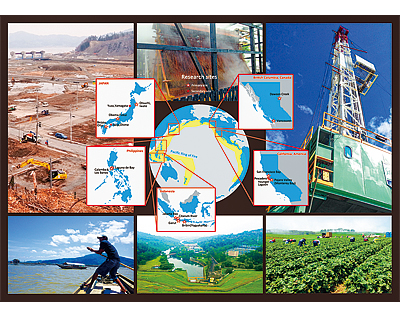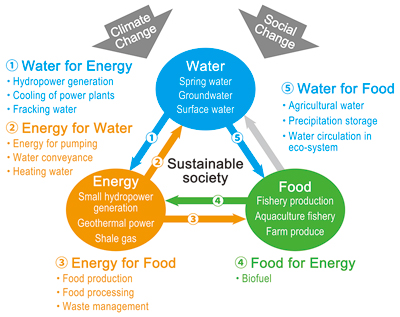Human-Environmental Security in Asia-Pacific Ring of Fire: Water-Energy-Food Nexus
Climate change and social change, including accelerating development, urbanization, and globalization are increasing pressure on water, energy and food resources, increasing the number of tradeoffs and potential conflicts among these resources that have their complex interactions. In order to address these issues, the objectives of the project were to understand the complexity of the water-energy-food (WEF) nexus system and to create policy options to reduce trade-offs among resources and to alleviate conflicts of resource users using scientific evidence and under assumptions of uncertainty to maximize human-environmental security. The project also proposed solutions to local and global environmental problems by contributing to global research networks associated with the Future Earth platform and the U.N. Sustainable Development Goals.
The project involved 60 researchers from different disciplines and five countries, including Indonesia, the Philippines, Canada, Japan and the USA. Five research groups carried out the following tasks: 1) the Water-Energy Nexus Group conducted biophysical measurement and analysis using space satellites, geothermic, and hydrogeological techniques; 2) the Water-Food Nexus Group carried out biophysical measurements and analyses using geochemical, coastal oceanographic, geophysical, hydrologic, and ecological methods, including isotopic tracers; 3) the Stakeholder Analysis Group conducted stakeholder and social network analyses, community surveys, and scenario planning based on social and behavioral science approaches; 4) the Socio-culture of Resource Usage Group developed the science-policy interface based on its examination of the socio-cultural history of groundwater use; and 5) the Interdisciplinary Group completed the research with a mission to: i) identify research problems; and ii) determine the methods and/or create new discipline-free methods based on synthesizing and harmonizing team-based production, collected from individual scientists in different disciplines from each team in order to assess human environmental security. In addition, the team further developed these approaches to incorporate non-scientific/non-disciplinary views on the analyses; and iii) design a nexus system.
Results
For the water-energy nexus component, we calculated the potential of using groundwater as a source of thermal energy in Obama. In Beppu, the subsurface environment, including flow of groundwater and hot springs, have been clarified by gravity measurement.
The Water-Food Nexus Group identified the location of submarine groundwater discharge at Obama and Beppu bays, and estimated the supply of nutrients conveyed from land to ocean by groundwater. Stakeholder analysis of hot spring resources also clarified key issues related to future scenarios and social change.
The Interdisciplinary Group developed several integrated methods, including models of Beppu and Otsuchi, Japan, Pajaro Valley, California, and British Columbia, Canada. This group also designed a nexus system at the local scale to understand the complexity of the nexus system and establish a clear definition of the nexus concept.
For collaborative scientific activities with society, we designed lectures open to local citizens and conducted a participatory survey on hot springs with local residences and stakeholders in Beppu. We developed a web page, the “Spring Map”, in order to share the results of our groundwater survey. Such activities with local governments and private sector raised awareness of nexus issues.
▲PAGE TOP
Figure 1 Target research sites

Figure 2 What is the Water, Energy and Food nexus?
